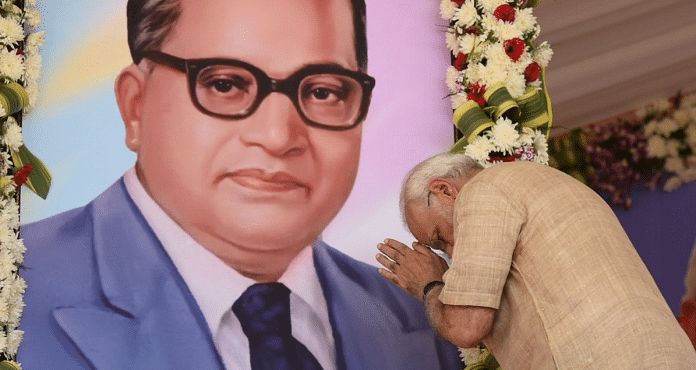An unusual public procession took place in Gujarat in January 2010. Perhaps, for the first time, a city in India was witnessing a parade carrying a giant replica of the Constitution on top of an elephant. Leading the procession was a beaming Narendra Modi, then Gujarat chief minister, alongside a statue of BR Ambedkar.
It was this image from 2010 that flashed through my mind while attending the launch of the new book Ambedkar and Modi: Reformer’s Ideas Performer’s Implementation. The book launched by former President Ramnath Kovind in New Delhi had former Supreme Court Chief Justice K.G. Balakrishnan in attendance. Speaking at the release, Kovind recalled how then-CM Modi demonstrated his faith and commitment to Ambedkar’s ideals and the Constitution with that rally, which was to be one of several such yatras over the years.
At the heart of Modi’s relationship with Ambedkar has been a consistent focus on the Indian Constitution and constitutional awareness. In fact, it would not be an exaggeration to state that it was only during Modi’s premiership that national consciousness on Ambedkar as the architect of the Indian Constitution got its maximum attention. It was Modi who ensured the release of an official gazette notification declaring 26 November as Constitution Day during his first term as prime minister. This was also followed up with a focused campaign on civic duties as enshrined in the Constitution. Turning it into a mass digital movement with an online portal with the Preamble in 23 languages and a Constitution quiz.
Sustained focus on Ambedkar and the Constitution has been a feature of the eight years of Narendra Modi in office as prime minister. This commitment stands in stark contrast to how the original Constitution as conceived by Ambedkar has been transmogrified since Independence.
Also read: From Lion Capital to Flag Code, Modi govt is shifting the meaning of India’s symbols
Too many amendments
Between the tenures of Jawaharlal Nehru, Indira Gandhi and Rajiv Gandhi as prime minister, the Indian Constitution as conceived by Dr BR Ambedkar was amended on more than 50 occasions while diluting and drastically altering its original provisions. In fact, collectively, all Congress governments have amended the Constitution 77 times, which is more than twice the number of amendments during the reign all other prime ministers put together.
The more than 100 amendments to the Constitution and the undemocratic manner in which the Indira Gandhi government amended the Preamble during the Emergency through the insertion of the words ‘socialism’ and ‘secularism’ are a repudiation of everything Ambedkar stood for and believed in. In fact, on 15 November 1948, the Constituent Assembly debated the very same issue of adding references to socialism in the Preamble and it was Ambedkar who emphatically rejected the demand. Ambedkar’s argument was that such an insertion would be a repudiation of democracy and amount to taking away the liberty of the people to decide what economic system is best suited for the country from time to time.
Also read: Why BJP is the rightful heir to the legacy of Ambedkar
Return to original form?
It is this progressive thinking of Ambedkar, going beyond constitutionalism, that underlies Modi’s reverence of him. From Ambedkar’s advocacy of urbanisation and industrialisation to his firm belief in education for all being a great leveller, it’s the ideals of Ambedkar that form the core of Modi’s various initiatives from Make in India to Swachh Bharat to the National Education Policy. The primal role of the Constitution in political empowerment as envisioned by Ambedkar has seen men and women of humble backgrounds rise to the highest political offices in India. Ambedkar and Modi is thus a timely intervention in public discourse located at the intersection of Ambedkar’s ideals and Modi’s reforms.
It would perhaps be a fitting tribute to Ambedkar if this public debate were to also deliberate on the question of restoring the Preamble to its original form, ridding it of the Emergency era insertions while reminding future generations of Ambedkar’s sagely wisdom as expressed by him in the Constituent Assembly on 15 November 1948:
What should be the policy of the State, how the Society should be organised in its social and economic side are matters which must be decided by the people themselves according to time and circumstances. It cannot be laid down in the Constitution itself, because that is destroying democracy altogether. If you state in the Constitution that the social organisation of the State shall take a particular form, you are, in my judgment, taking away the liberty of the people to decide what should be the social organisation in which they wish to live…I do not see therefore why the Constitution should tie down the people to live in a particular form and not leave it to the people themselves to decide it for themselves.
Shashi Shekhar Vempati is former CEO of Prasar Bharati, India’s Public Service Broadcaster. He tweets @shashidigital. Views are personal.



